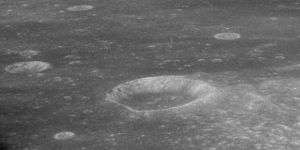Webb (crater)
 | |
| Coordinates | 0°54′S 60°00′E / 0.9°S 60.0°ECoordinates: 0°54′S 60°00′E / 0.9°S 60.0°E |
|---|---|
| Diameter | 21 km |
| Depth | 0.8 km |
| Colongitude | 300° at sunrise |
| Eponym | Thomas W. Webb |

Webb is a small lunar impact crater that is located near the eastern edge of the Mare Fecunditatis, in the eastern part of the Moon near the equator. It is to the north of the prominent crater Langrenus, and west of Maclaurin and the smaller Hargreaves, it is also north-northeast of Naonobu.

The interior of Webb is relatively dark compared with the inner walls of the rim, and it has a low hill at the midpoint of the interior. On the lunar mare to the north is a faint marking of a ray system that appears to radiate from this crater.
West of the crater is a wrinkle ridge known as Dorsa Andrusov.
Satellite craters
By convention these features are identified on lunar maps by placing the letter on the side of the crater midpoint that is closest to Webb. Three of its satellite craters are larger than itself, Webb P located to the northwest is partly a ghost crater in its south, also Webb C located in the east is largely a ghost crater.

| Webb | Latitude | Longitude | Diameter |
|---|---|---|---|
| B | 0.8° S | 58.4° E | 6 km |
| C | 0.3° N | 63.8° E | 34 km |
| D | 2.3° S | 57.6° E | 7 km |
| E | 1.0° N | 61.1° E | 7 km |
| F | 1.5° N | 61.0° E | 9 km |
| G | 1.7° N | 61.2° E | 9 km |
| H | 2.1° S | 59.5° E | 10 km |
| J | 0.6° S | 64.0° E | 24 km |
| K | 0.7° S | 62.9° E | 21 km |
| L | 0.1° N | 62.7° E | 7 km |
| M | 0.2° S | 63.8° E | 5 km |
| N | 0.3° S | 63.6° E | 4 km |
| P | 2.3° S | 57.8° E | 36 km |
| Q | 1.0° S | 61.2° E | 5 km |
| U | 1.8° N | 56.3° E | 6 km |
| W | 3.0° N | 58.2° E | 8 km |
| X | 3.2° N | 58.3° E | 8 km |
The following craters have been renamed by the IAU.
- Webb R — See Condon (crater).
References
- Andersson, L. E.; Whitaker, E. A. (1982). NASA Catalogue of Lunar Nomenclature. NASA RP-1097.
- Blue, Jennifer (July 25, 2007). "Gazetteer of Planetary Nomenclature". USGS. Retrieved 2007-08-05.
- Bussey, B.; Spudis, P. (2004). The Clementine Atlas of the Moon. New York: Cambridge University Press. ISBN 978-0-521-81528-4.
- Cocks, Elijah E.; Cocks, Josiah C. (1995). Who's Who on the Moon: A Biographical Dictionary of Lunar Nomenclature. Tudor Publishers. ISBN 978-0-936389-27-1.
- McDowell, Jonathan (July 15, 2007). "Lunar Nomenclature". Jonathan's Space Report. Retrieved 2007-10-24.
- Menzel, D. H.; Minnaert, M.; Levin, B.; Dollfus, A.; Bell, B. (1971). "Report on Lunar Nomenclature by the Working Group of Commission 17 of the IAU". Space Science Reviews. 12 (2): 136–186. Bibcode:1971SSRv...12..136M. doi:10.1007/BF00171763.
- Moore, Patrick (2001). On the Moon. Sterling Publishing Co. ISBN 978-0-304-35469-6.
- Price, Fred W. (1988). The Moon Observer's Handbook. Cambridge University Press. ISBN 978-0-521-33500-3.
- Rükl, Antonín (1990). Atlas of the Moon. Kalmbach Books. ISBN 978-0-913135-17-4.
- Webb, Rev. T. W. (1962). Celestial Objects for Common Telescopes (6th revised ed.). Dover. ISBN 978-0-486-20917-3.
- Whitaker, Ewen A. (1999). Mapping and Naming the Moon. Cambridge University Press. ISBN 978-0-521-62248-6.
- Wlasuk, Peter T. (2000). Observing the Moon. Springer. ISBN 978-1-85233-193-1.
| Wikimedia Commons has media related to Webb (crater). |